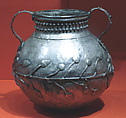Vase with vine, leaves and berries on the body
Roman Period or later
Many artworks of the Roman Period in Egypt represent the taste of wealthy urban merchant and rich farming classes of Roman Egypt. Wide trade of luxury works is evident, and Greco-Roman style dominates.
Since Egyptian pharaohs had first authorized Greek trading colonies and employed Greek mercenaries in the seventh century BC., there was a considerable Greek presence in Egypt. With Alexander's conquest, Macedonian Greek Ptolemies ruled as successors to the pharaohs, and Ptolemaic Greek and eastern Mediterranean soldiery was heavily settled in parts of Egypt. Although the Ptolemaic kings maintained traditional Egyptian religious and political forms, elite society, of mixed Greek and Egyptian descent, aspired to Greek culture in many respects. With the replacement of a Ptolemaic pharaoh in Memphis and Alexandria by a Roman emperor in Rome, the status of Greek culture and art, if anything, increased. However, multiple cultural influences were t play, and their reconciliation differed, depending on the identity of the patron and on whether personal, public, religious, or funerary purposes were in question.
This vessel is thought to be from the town of Djeme, a major long-lived town that had overtaken the 20th Dynasty Temple of Medinet Habu in Thebes. It came to the museum along with another silver vessel said to be from the same source, which belongs stylistically to the Late Antique Period (30.8.124).
Due to rights restrictions, this image cannot be enlarged, viewed at full screen, or downloaded.

